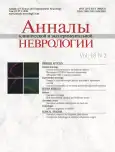A man who changed six spectacles: а case of Heidenhain variant of the Creutzfeldt–Jakob disease
- 作者: Thiruvuru I.1, Hazeena P.1, Ramesh R.1, Shanmugam S.1, Avadhani D.1
-
隶属关系:
- Sri Ramachandra Institute of Higher Education and Research
- 期: 卷 18, 编号 2 (2024)
- 页面: 95-99
- 栏目: Clinical analysis
- URL: https://journals.rcsi.science/2075-5473/article/view/262429
- DOI: https://doi.org/10.17816/ACEN.977
- ID: 262429
如何引用文章
详细
Creutzfeldt–Jakob Disease (CJD) is a rare and rapidly progressive condition. A 54-year-old professor initially presented with insidious, progressive visual symptoms. Imaging suggested post-infectious encephalitis, but symptoms progressed to ataxia, coordination difficulties, and cognitive decline. Repeat MRI revealed findings consistent with CJD, supported by clinical and electrophysiological evidence. Though 14-3-3 protein in CSF was inconclusive, Heidenhain variant CJD was strongly suspected. Isolated visual symptoms progressing rapidly alongside ataxia and dementia prompt suspicion of this variant. Clinical examination, neuroimaging, and EEG play crucial roles in the diagnosis.
作者简介
Ishwarya Thiruvuru
Sri Ramachandra Institute of Higher Education and Research
Email: madhandhoni@gmail.com
ORCID iD: 0009-0003-7261-5151
MD, senior resident, Department of neurology, Sri Ramachandra Institute of Higher Education and Research
印度, Porur, ChennaiPhilo Hazeena
Sri Ramachandra Institute of Higher Education and Research
Email: philohazeena@yahoo.co.in
ORCID iD: 0000-0001-6221-431X
MD (DM Neuro), associate professor, Department of neurology, Sri Ramachandra Institute of Higher Education and Research
印度, Porur, ChennaiRithvik Ramesh
Sri Ramachandra Institute of Higher Education and Research
编辑信件的主要联系方式.
Email: rithvy@gmail.com
ORCID iD: 0000-0002-4142-637X
MD (DM Neuro), assistant professor, Department of neurology, Sri Ramachandra Institute of Higher Education and Research
印度, Porur, ChennaiSundar Shanmugam
Sri Ramachandra Institute of Higher Education and Research
Email: drradnus@gmail.com
ORCID iD: 0000-0002-6580-9017
MD (DM Neuro), Professor, Head, Department of neurology, Sri Ramachandra Institute of Higher Education and Research
印度, Porur, ChennaiDeepa Avadhani
Sri Ramachandra Institute of Higher Education and Research
Email: doctordeepaavadhani@gmail.com
ORCID iD: 0009-0004-0991-9563
MD (DM Neuro), Assistant professor, Department of neurology, Sri Ramachandra Institute of Higher Education and Research
印度, Porur, Chennai参考
- Kropp S., Schulz-Schaeffer W.J., Finkenstaedt M. et al. The Heidenhain variant of Creutzfeldt–Jakob disease. Arch. Neurol. 1999;56(1):55–61. doi: 10.1001/archneur.56.1.55.
- Cooper S.A., Murray K.L., Heath C.A. et al. Isolated visual symptoms at onset in sporadic Creutzfeldt–Jakob disease: the clinical phenotype of the “Heidenhain variant”. Br. J. Ophthalmol. 2005;89(10):1341–1342. doi: 10.1136/bjo.2005.074856
- Cornelius J.R., Boes C.J., Ghearing G. et al. Visual symptoms in the Heidenhain variant of Creutzfeldt–Jakob disease. J. Neuroimaging. 2009;19(3):283–287. doi: 10.1111/j.1552-6569.2008.00294.x
- Keyrouz S.G., Labib B.T., Sethi R. MRI and EEG findings in Heidenhain variant of Creutzfeldt–Jakob disease. Neurology. 2006;67(2):333. doi: 10.1212/01.wnl.0000208487.18608.41
- Geschwind M.D., Martindale J., Miller D. et al. Challenging the clinical utility of the 14-3-3 protein for the diagnosis of sporadic Creutzfeldt–Jakob disease. Arch. Neurol. 2003;60(6):813-816. doi: 10.1001/archneur.60.6.813
补充文件









